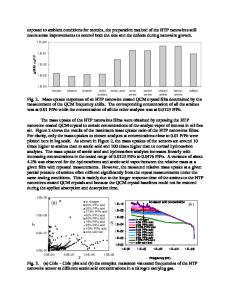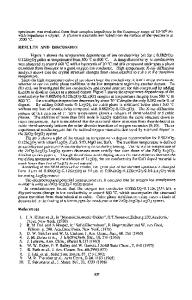Chemical Sensors Based on Individual In 2 O 3 Nanowires
- PDF / 124,218 Bytes
- 6 Pages / 595 x 842 pts (A4) Page_size
- 60 Downloads / 347 Views
Q11.9.1
Chemical Sensors Based on Individual In2O3 Nanowires
Daihua Zhang, Chao Li, Xiaolei Liu, Song Han, Tao Tang and Chongwu Zhou Department of E.E.-Electrophysics, University of Southern California, Los Angeles, California 90089, U. S. A ABSTRACT Single crystalline In2O3 nanowires were synthesized and then utilized to construct field effect transistors (FETs) consisting of individual nanowires. Chemical sensors based on these In2O3 nanowire FETs have been demonstrated. Upon exposure to gaseous molecules such as NO2 and NH3, the electrical conductance of the In2O3 nanowire FETs are found to dramatically decrease rapidly, accompanied by substantial shifts in threshold gate voltage. Our In2O3 nanowire sensors exhibit significantly improved sensitivity, as well as shortened response times compared to most existing solid-state gas sensors. In addition, ultraviolet (UV) light is found to be able to greatly enhance the surface molecular desorption kinetics and serve as a “gas cleanser” for the In2O3 nanowire chemical sensors. It has been demonstrated that the recovery time of our devices can be shortened to ~30 s by illuminating the devices with UV light in vacuum. INTRODUCTION Semiconducting one-dimensional structures, such as Si nanowires [1] and SnO2 nanoribbons [2, 3] have been extensively studied as biological and chemical sensors recently due to their advantageous features such as good sensitivity to the ambient conditions and simplicity in fabrication. Because of their ultra-high surface-to-volume ratios, nanowires/ nanobelts are expected to be superior gas sensor candidates and alternatives of thin-film sensors that have been found to have many crucial limitations [4]. In2O3, as a semiconducting oxide, has been demonstrated to be an excellent sensing material by fairly many film-sensing studies [4, 5]. However, the chemical sensing properties of In2O3 nanowires were rarely reported, presumably due to the difficulty in material synthesis in the past. Based on our recent success regarding the synthesis of high-quality single-crystalline In2O3 nanowires [6], we have intensively studied the gas sensing properties of the individual In2O3 nanowires to NO2 and NH3 gases. In this letter, we will present our unique approach of using transistors based on these fascinating materials as toxic chemical sensors. The In2O3 nanowires showed sensitivities up to several orders and great stabilities at room temperature. EXPERIMENTAL DETAILS Single-crystalline In2O3 nanowires were synthesized by a laser ablation method, details of which can be found in our previous publication [6]. This method produced In2O3 nanowires with diameters ~ 10 nm and lengths ~ 5 µm. A high resolution TEM (HRTEM)
Downloaded from https://www.cambridge.org/core. Rice University, on 03 Feb 2020 at 07:39:35, subject to the Cambridge Core terms of use, available at https://www.cambridge.org/core/terms. https://doi.org/10.1557/PROC-776-Q11.9
Q11.9.2
image is displayed in figure 1 (a). The lattice spacing along the [110] growth direction (0.72 nm) is in g
Data Loading...











